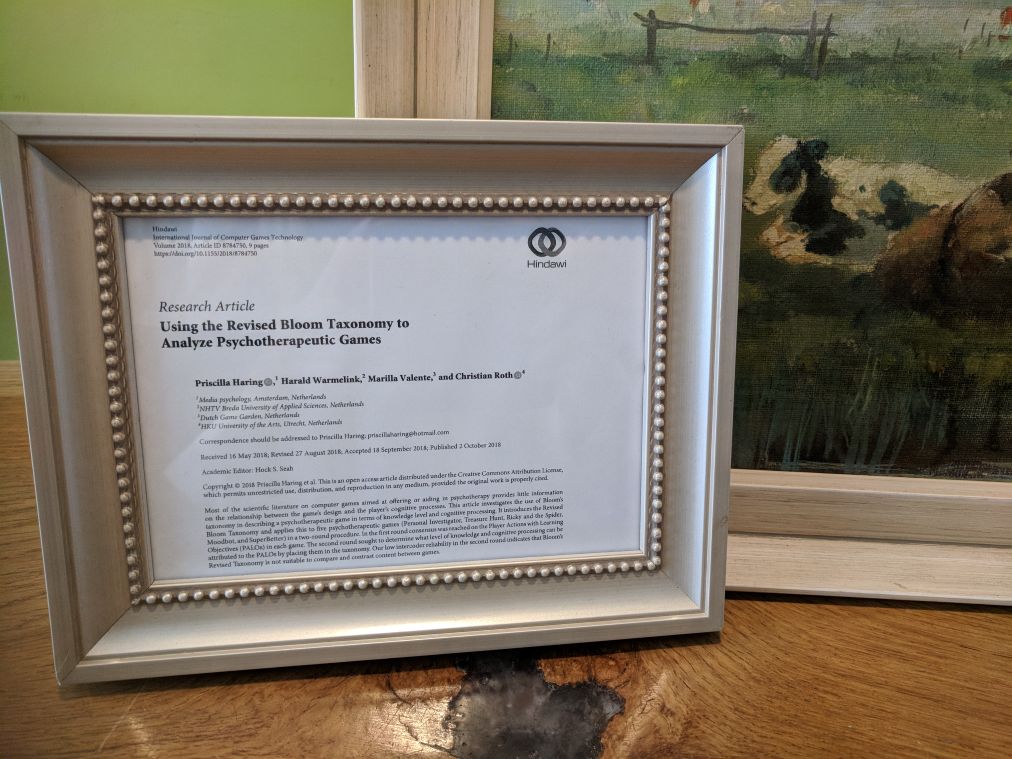One challenge that researching games has, is how to describe game content and especially capturing ongoing psychological processes in a way that makes them comparable. We tried to capture gaming behaviour in Blooms taxonomy which is a popular tool for objectives-based evaluation as it allowed for a high level of detail when stating learning objectives.
Stating a learning objective requires a verb and an object, where the verb refers to the intended cognitive process and the object refers to the knowledge level that must be acquired or constructed [1]. We used this verb/object structure to formulate Player Actions with a Learning Objective (PALO) for five different psychotherapeutic games, among which the game Personal Investigator.

Personal Investigator is a single-player 3D computer game with role-playing characteristics. In the game the player becomes the personal investigator that “hunts for solutions to personal problems,” keeping a notebook along the way to keep a record of the hunt and the solutions found. It is played over roughly three therapy sessions, taking just over half of the one-hour session each time. During the sessions, the player plays the game on the computer, while the therapist observes and offers explanations if requested.
Personal Investigator is based on Solution Focused Therapy (SFT) and aimed at adolescent psychological patients. SFT is “a structured rather than a freeform therapeutic model,” similar to Cognitive Behavioural Therapy. The game is meant to help adolescent patients go through five different conversational steps with their therapists. These five steps are translated into five main areas in the 3D game world, where the player interacts with nonplaying characters [2].
13 PALOs in Personal Investigator
(1) The player is asked to give a detective name to his/her avatar.
(2) The player is asked to write down a problem he/she has that they would like to work on in the detective notebook.
(3) The player is asked to turn a problem into a goal they would like to achieve—this becomes the goal of the game.
(4) The player is encouraged to think about situations in which the problem that is opposite of the goal is absent or less prevalent.
(5) The player is encouraged to understand (but we do not know how) what they are doing differently when the problem is absent or less prevalent.
(6) The player is asked to set goals for repeating the behaviours that result from action 5 more often.
(7) The player is asked to write about how he/she copes with difficult situations.
(8) The player is asked to write about positive, active ways of coping that draw on their strengths and interests.
(9) The player is asked to identify people that can help achieve the goal (in real life).
(10) The player is asked to think about personal strengths and write down in the detective notebook things they are good at and past successes.
(11) The player is asked to draw the answer to the Miracle Question in their detective notebook.
(12) The player is asked to write down what they and others would think, feel, and do differently after the Miracle.
(13) The player is asked to rate on a scale of 1-10 how close they are to achieving this new future.

We found that applying Bloom’s Revised Taxonomy to our five games provided a structured discussion of player actions in relation to cognitive processes, knowledge levels, and design goals. We feel that such discussions would be useful in the design process of psychotherapeutic games. Describing possible player actions in terms of a PALO provided an interesting perspective on the translation of (therapeutic) goals into game content.
Can Bloom’s Revised Taxonomy Be Used as a Checklist during the Design of a Psychotherapeutic Game? Our discussion to formulate PALOs provided a structured way of describing how game design connects player actions to certain objectives and might provide support during the design process of a psychotherapeutic game. Attempting to place these PALOs in the taxonomy establishes a discussion of the game content on the level of cognition. Although categorization of content based on Bloom’s Revised Taxonomy is too subjective to be used as a design checklist, we do feel the process facilitates a discussion of high value.
Can Bloom’s Revised Taxonomy Support Psychologists in Making a More Informed Choice Concerning Psychotherapeutic Games That Might Be Included in Their Therapy? By describing content in terms of Player Actions with Learning Objectives, the designers provide a better insight into how their choices relate to the intended processing by the player and the desired overall outcome of gameplay. This gives any therapist a better insight into the level of cognitive engagement envisioned (lower bound) for different game content, which would support a more informed choice.
Although, we have established that Bloom’s Revised Taxonomy cannot be used as an objective classification of game content for psychotherapeutic games due to very low intercoder reliability. We did find the process of describing Player Actions with Learning Objectives of value, as it forces game designers to formalize their intentions.
All is described in more detail, and with all five psychotherapeuric games in our paper “Using the Revised Bloom Taxonomy to Analyze Psychotherapeutic Games”

References
[1] L. W. Anderson, D. R. Krathwohl, and B. S. Bloom, A taxonomy for learning, teaching, and assessing: A revision of Bloom’s taxonomy of educational objectives, Allyn & Bacon, 2001.
[2] D. Coyle, M. Matthews, J. Sharry et al., “Personal Investigator: A therapeutic 3D game for adolecscent psychotherapy,” Interactive Technology and Smart Education, vol. 2, no. 2, pp. 73–88, 2005.
